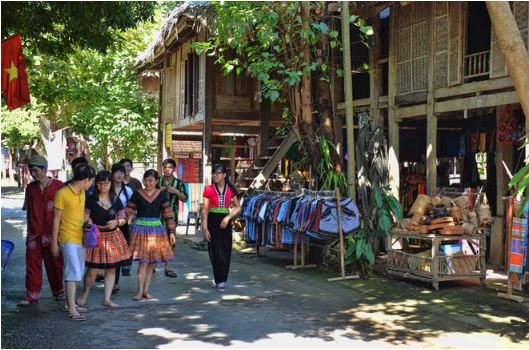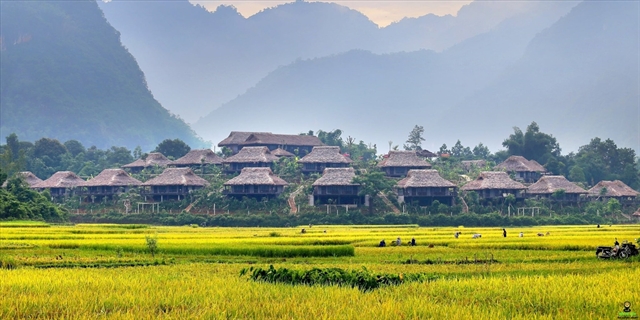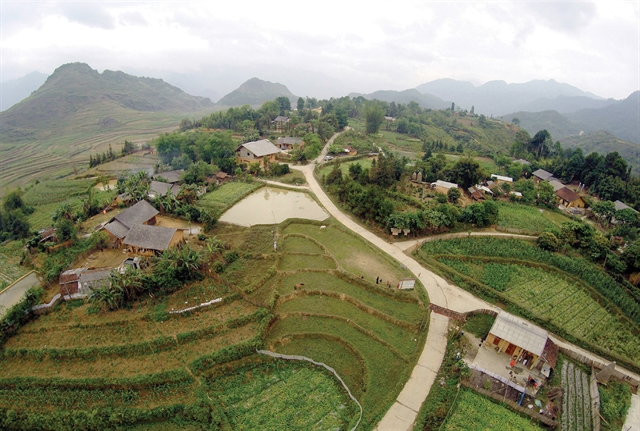 Sunday/Weekend
Sunday/Weekend

 |
| Lác Hamlet in Hòa Bình Province is a famous community-based tourism site. VNAVNS Photo |
Taking the community as the centre to promote tourism brings economic benefits to the local community, contributes effectively to conservation efforts, and enhances the value of the natural and cultural resources of each region.
Programmes supporting community-based tourism development, aimed at sustainability, need to be built and promoted.
According to Phạm Hải Quỳnh, director of the Asian Tourism Institute (ATI) and chairman of the Việt Nam Community Tourism Association (VCTC), to develop community-based tourism, the role of local leadership and community participation is crucial.
The right points for community-based tourism development must be chosen, focusing on cultural values, natural landscapes, and the community itself as the foundation.
In the northern province of Hoà Bình, there is a famous community-based tourism site called Lác Hamlet in Mai Châu District, which has been developed for a long time and has become the main source of income for local residents.
 |
| Lác Hamlet is the first community-based tourism destination developed in the northern mountainous region of Việt Nam. — VNA/VNS Photo |
Aside from the natural landscapes, the community also boasts the traditional cultural identity of 121 households of the Thái ethnic minority.
Thanks to tourism business, the average income of Lác Hamlet residents reached VNĐ27 million per person per year in 2019.
Many families specialising in tourism services even earned up to VNĐ300 million each per year.
From this model, the province has developed many community-based tourism models that provide livelihoods for its people.
Meanwhile, the people of A Lưới District in the central province of Thừa Thiên Huế only started community-based tourism in 2018, but it also contributed to improving their lives.
From their daily activities, the locals created the product "A Day as an Ethnic Pa Cô", providing interesting experiences for tourists visiting their localities.
Travel agencies have included A Lưới in their tour itineraries to serve guests while the local government has been supporting and listening to feedback from tourism agencies.
Today, the tourism products and service infrastructure in A Lưới are more complete, diverse, and abundant. It has become a preferred destination for tourists.
Back to northern Việt Nam, a notable success in developing community-based tourism is in Nà Sự Hamlet, Chà Nưa Commune, Nậm Pồ District, Điện Biên Province.
This place is blessed with favourable natural conditions, beautiful scenery, and is located alongside a stream and along the tourism route from Điện Biên Phủ City to the A Pa Chải border junction in Sín Thầu Commune, Mường Nhé District.
The hamlet started receiving guests in late 2022, bringing more income to the community, promoting the beauty of rural villages to tourists, and opening up a new direction for the people by promoting sustainable rural development.
Last year the community-based tourism households in Nà Sự Hamlet hosted over 5,000 tourists, an impressive figure for a remote village over 100km away from the centre of Điện Biên Phủ City.
Reducing pressure
Community-based tourism needs to be strongly promoted in Việt Nam’s Tourism Development Strategy until 2030 to boost sustainable tourism, exploit the advantages of each locality, and enhance regional connectivity.
In particular, community-based tourism is helping to reduce pressure on tourism centres in major provinces and cities such as Hà Nội, Quảng Ninh, Lào Cai, Thừa Thiên Huế, Quảng Nam, Đà Nẵng, Hồ Chí Minh City, and Cần Thơ.
Nguyễn Trùng Khánh, director of the Việt Nam National Authority of Tourism (VNAT) under the Ministry of Culture, Sports, and Tourism, said that the community-based tourism models were developing in many localities such as Sơn La, Điện Biên, Nghệ An, Thừa Thiên Huế, Đồng Tháp, Tiền Giang, Bến Tre, Đắk Lắk, Kon Tum, Khánh Hòa, and even major cities such as Hà Nội, Đà Nẵng and Hải Phòng.
According to statistics from the VNAT, by 2020 there were about 300 villages, hamlets, communities, and neighbourhoods doing community-based tourism across the country.
Many destinations have achieved certain standards and won international awards.
Remarkably the ASEAN Community Tourism Award in 2023 was given to the Quản Bạ Community Tourism Service Cooperative in Hà Giang, Sin Suối Hồ community-based tourism village in Lai Châu, Tân Thành fishing village in Quảng Nam, and Thái Hải eco-ethnic cultural village conservation area in Thái Nguyên.
 |
| Community-based tourism, which is significant in Hà Giang Province, is helping to reduce pressure on big tourism centres. — VNA/VNS Photo |
Tân Hóa Village in Minh Hóa District, Quảng Bình, an ideal destination for tourists, especially international visitors, was recently honoured by the World Tourism Organisation (UNWTO) as the "Best Village Tourism Destination in the World 2023".
In Tân Hoá, tourists could not only admire the pristine beauty of the peaceful village, but also explore the Tú Làn Cave system consisting of 10 different caves with beautiful, mystical stalactites.
From a village prone to floods and other natural disasters, Tân Hoá has gradually shaped its image on the tourism map, and is suitable for sustainable development trends and adapting to climate change.
Khánh emphasised that community-based tourism in Việt Nam had demonstrated an important role in the industry's development, mobilising the participation of many investors.
Many localities had begun to establish agriculture models linked with rural tourism, community-based tourism, numerous traditional craft villages, and distinctive cultural identities of ethnic groups, bringing positive results.
However, the development of community-based tourism also needed more attention from localities to avoid duplication, simplicity in products, and excessive exploitation of natural resources, which could impact the environment.
More importantly, there was a need to continue researching and implementing specific support policies for the sustainable development of this tourism model. VNS




